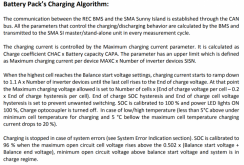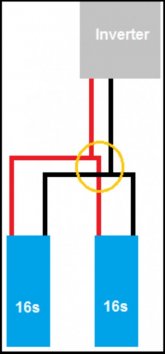Parallel cells is easy and works well, with one BMS just treating each cell group as one larger cell. This is what Tesla does with a huge number of small cells.
Running 2 strings has one big advantage. If something does go wrong, there is still one good string that could keep you running at half capacity. The other advantage is being able to use two 100 amp BMS units and getting 175 amp capability. It won't double, no matter how close you think you matched the cables etc.
The disadvantage is trying to keep the two matched. If they have quality BMS's and closely matched cable resistance, they can stay in pretty good balance, but it is possible for them to drift. Paralleling the cells will get you double the current capacity as they are forced to balance the load with the low resistance connection between each cell pair.
My setup is a hybrid, which I know will make some cringe. I have two strings that are 3P each, but then I have the buss bars of the two strings joined by fused #16 wires that then go to the BMS. The resistance is low enough that it will hold the two cell groups in balance to each other with up to 5 amps between the cell groups before it would pop a fuse. The strings are each fused at 125 amps, and then the pair is fused at 200 amps with a Class T fuse at the output of the batter box. My single balancer/BMS is the JK (Heltec) with 2 amp active balancing and 200 amp continuous, 350 amp peak current rating. I dialed it down to 160 amp discharge, and 100 amp charge for the BMS over current cut off. I have pulled some of the fuses and checked the current between the two strings at random times and random cells, and I never see more than a few milliamps balancing between the strings. These cells are far better matched that I ever could have hoped for. This arrangement might not work so well for random commodity cells.
As long as your maximum charge rate is well below what the cells can take, I do not see a need for charge tapering. LG rates my cells to take 1C charge rate. That would be 360 amps. In a worst case setup, my charge rate can't exceed 140 amps (XW-Pro charging limit) but I have it set much lower than that. Typically under 30 amps when the grid is up, and if I was under a grid out situation, and my full solar array was dumping into the batter, it would just hit 80 amps. I tested it to 80 amps and everything works just fine. That is only a 0.22C rate.
I have yet to see a system setup where the BMS is actively commanding the charge current to roll off due to a single cell reaching close to full charge. The only function I see in the Schneider manual is reporting the "State of Charge" via their "Xanbus" to use that value for when it can activate grid support functions or trigger a recharge. I do not see any controls for adjusting the charge current rate, other than to cut off charging if the SOC reaches your desired limit. And it can cut off inverter functions based on SoC levels as well, but again, not with linear current changes, just on or off. For example, it can only sell power to the grid when the SoC is above a target value.
I do see where being able to taper current could help, but I just have not seen anyone do it.






